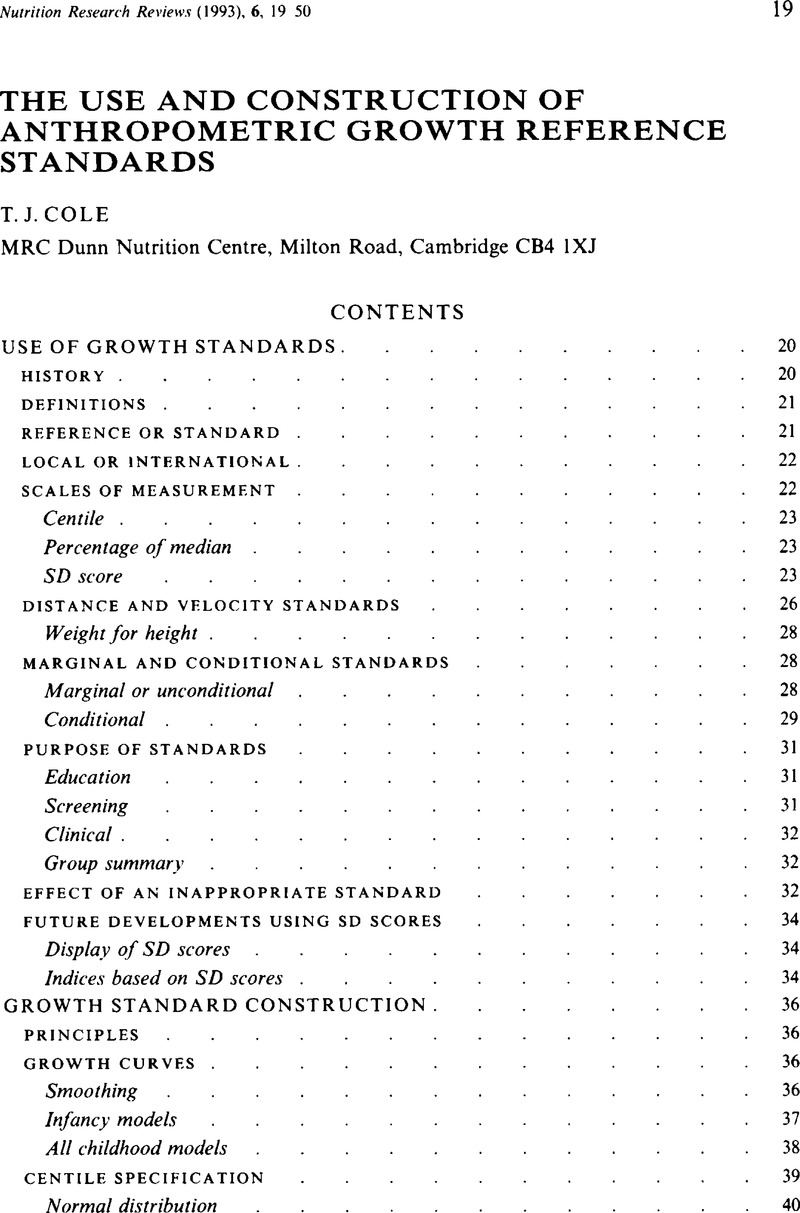Crossref Citations
This article has been cited by the following publications. This list is generated based on data provided by Crossref.
Lindgren, G
Strandell, A
Cole, T
Healy, M
and
Tanner, J
1995.
Swedish population reference standards for height, weight and body mass index attained at 6 to 16 years (girls) or 19 years (boys).
Acta Paediatrica,
Vol. 84,
Issue. 9,
p.
1019.
Cole, T J
1995.
Conditional reference charts to assess weight gain in British infants..
Archives of Disease in Childhood,
Vol. 73,
Issue. 1,
p.
8.
Macfarlane, Sarah B.J.
1996.
The relationship between anthropometric indices derived from the CDC/WHO international reference.
Annals of Human Biology,
Vol. 23,
Issue. 6,
p.
421.
Asefa, Makonnen
Drewett, Robert
and
Hewison, Jenny
1996.
An Ethiopian birth cohort study.
Paediatric and Perinatal Epidemiology,
Vol. 10,
Issue. 4,
p.
443.
Panter-brick, C.
Todd, A.
and
Baker, R.
1996.
Growth status of homeless Nepali boys: Do they differ from rural and urban controls?.
Social Science & Medicine,
Vol. 43,
Issue. 4,
p.
441.
Ledford, A.W.
and
Cole, T.J.
1998.
Mathematical models of growth in stature throughout childhood.
Annals of Human Biology,
Vol. 25,
Issue. 2,
p.
101.
Tershakovec, Andrew M.
Watson, Miriam H.
Wenner, William J.
and
Marx, Alison L.
1999.
Insurance reimbursement for the treatment of obesity in children.
The Journal of Pediatrics,
Vol. 134,
Issue. 5,
p.
573.
Fung, Ellen B.
Barden, Elizabeth M.
Wasserman, Dror
Zemel, Babette S.
Heinrich, Barbara T.
Scanlin, Thomas F.
and
Stallings, Virginia A.
1999.
A Six-Month Study of Growth and Energy Expenditure in Children with Cystic Fibrosis Taking a Pulmonary Inhalation Medication (rhDNase).
Journal of the American College of Nutrition,
Vol. 18,
Issue. 4,
p.
330.
Remontet, L.
Mamelle, N.
Locard, E.
and
Lehingue, Y.
1999.
Courbes de croissance de la naissance à 6 ans: croissance en poids, taille et périmètre crânien selon le sexe.
Archives de Pédiatrie,
Vol. 6,
Issue. 5,
p.
520.
Sellen, Daniel W.
1999.
Polygyny and child growth in a traditional pastoral society.
Human Nature,
Vol. 10,
Issue. 4,
p.
329.
Flegal, Katherine M
1999.
Curve smoothing and transformations in the development of growth curves.
The American Journal of Clinical Nutrition,
Vol. 70,
Issue. 1,
p.
163S.
Pere, A.
2000.
Comparison of two methods for transforming height and weight to Normality.
Annals of Human Biology,
Vol. 27,
Issue. 1,
p.
35.
FUNG, E.B.
MALINAUSKAS, B.M.
KAWCHAK, D.A.
KOH, B.Y.
ZEMEL, B.S.
GROPPER, S.S.
OHENE-FREMPONG, K.
and
STALLINGS, V.A.
2001.
Energy expenditure and intake in children with sickle cell disease during acute illness.
Clinical Nutrition,
Vol. 20,
Issue. 2,
p.
131.
Fung, Ellen B.
Barden, Elizabeth M.
Kawchak, Deborah A.
Zemel, Babette S.
Ohene-Frempong, Kwaku
and
Stallings, Virginia A.
2001.
Effect of Hydroxyurea Therapy on Resting Energy Expenditure in Children With Sickle Cell Disease.
Journal of Pediatric Hematology/Oncology,
Vol. 23,
Issue. 9,
p.
604.
Cole, Tim J.
2002.
Human Growth and Development.
p.
383.
James Cole, Timothy
2002.
Assessment of growth.
Best Practice & Research Clinical Endocrinology & Metabolism,
Vol. 16,
Issue. 3,
p.
383.
Joffe, Tracey H.
Cole, Timothy J.
Wells, Jonathan C.K.
Geary, Michael P.
Rodeck, Charles H.
and
Hindmarsh, Peter C.
2003.
A new method for quantifying encephalization in the growing individual.
Journal of Theoretical Biology,
Vol. 225,
Issue. 3,
p.
361.
Serra Majem, Lluís
Ribas Barba, Lourdes
Aranceta Bartrina, Javier
Pérez Rodrigo, Carmen
Saavedra Santana, Pedro
and
Peña Quintana, Luis
2003.
Obesidad infantil y juvenil en España. Resultados del Estudio enKid (1998-2000).
Medicina Clínica,
Vol. 121,
Issue. 19,
p.
725.
Argyle, J.
2003.
Approaches to detecting growth faltering in infancy and childhood.
Annals of Human Biology,
Vol. 30,
Issue. 5,
p.
499.
Moestue, H
de Pee, S
Hall, A
Hye, A
Sultana, N
Ishtiaque, M Z
Huq, N
and
Bloem, M W
2004.
Conclusions about differences in linear growth between Bangladeshi boys and girls depend on the growth reference used.
European Journal of Clinical Nutrition,
Vol. 58,
Issue. 5,
p.
725.





